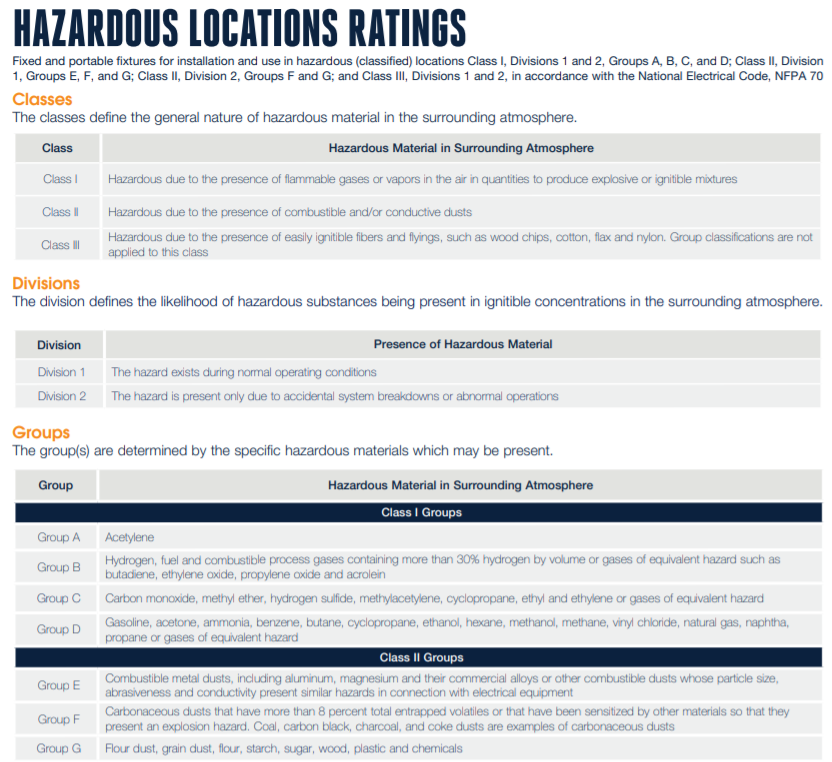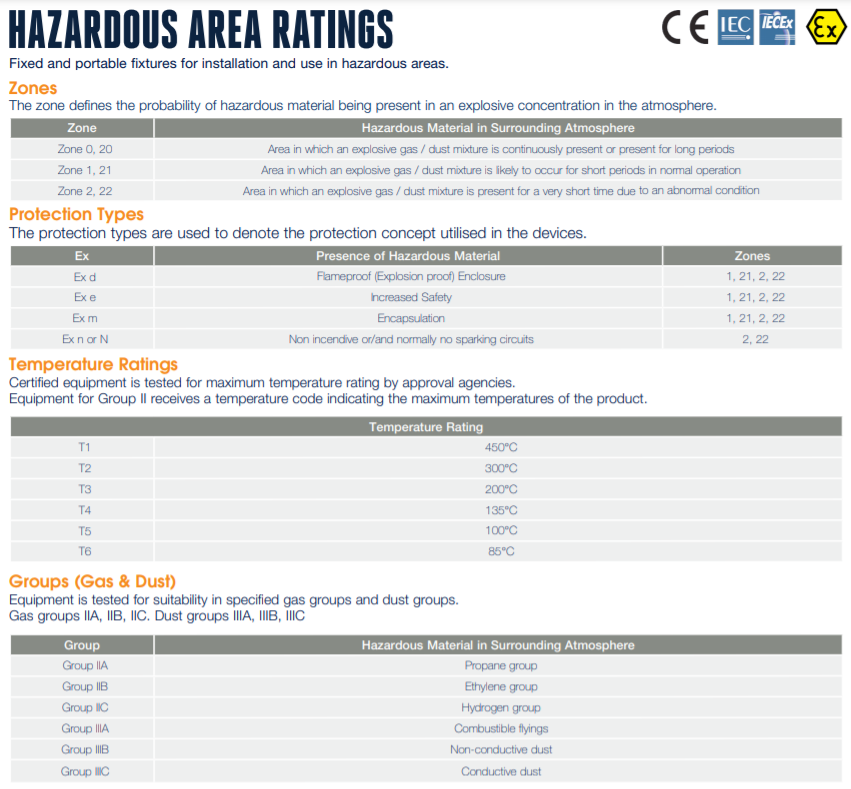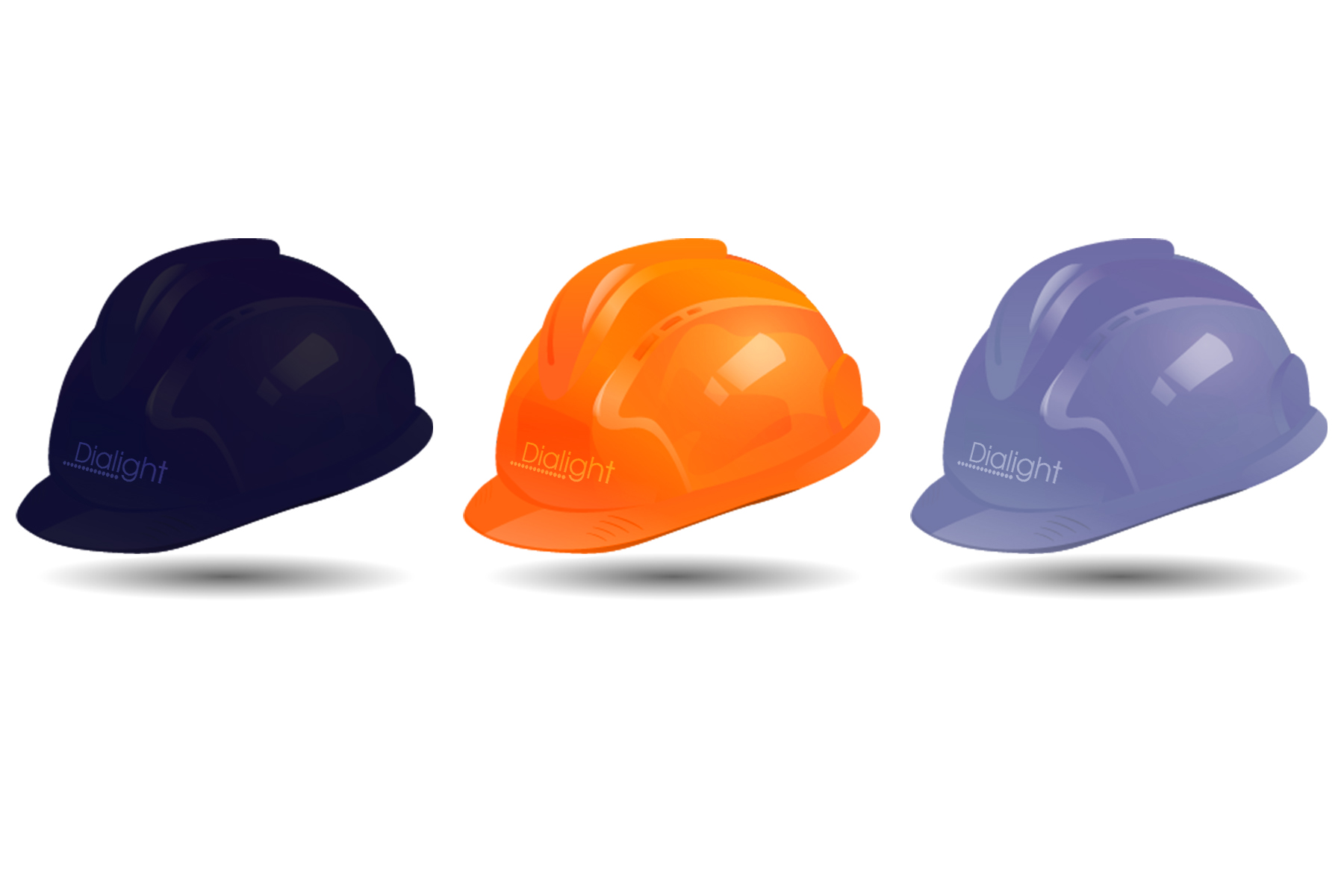Dependable electronics are an absolute necessity in hazardous environments. However, the combination of combustible gases or dusts with an arc or a spark from these products has the potential to cause devastating fires or explosions. Whether you are at the chemical plant, on your oil platform or offshore drilling rig, in your mill or somewhere equally as dangerous, all of your equipment is likely carrying a hazardous rating like Class I Div 2, Class I Div 1, IECEx/ATEX Zone 1 or Zone 2. But what does that mean exactly and how does this affect what lighting you should buy? Read on for more clarity on hazardous environments and ratings.
What is a hazardous location?
Hazardous locations are in more places than you think and it’s important to be aware of them if you are purchasing electronic equipment including LED lighting. Even your local gas/petrol station is considered a hazardous location because of the potential for an explosion. If, for example, a spark or lit cigarette collides with a drop or puddle of gasoline - FIRE! Your gas station needs hazardous-rated lighting.
According to UL (a US-based global certification laboratory), a hazardous location is “where explosion or fire hazards exist due to the presence of flammable gases, flammable or combustible liquid-produced vapors, combustible dusts, or ignitable fibers or flyings.”
This could mean anything from the obvious like a drilling rig or chemical plant where highly flammable substances are being mined or processed. Or it could mean the less obvious like a mill or sugar processing facility where the minute particles in the air have the potential to create a spark in the right conditions. Each facility is rated differently, based on their potential for explosion, which we’ll dive deeper into below.
What are some of the hazardous UL Ratings?
UL ratings are seen and adhered to most often in North America but does apply to countries in South America, Asia, and the Middle East. When looking at a hazardous UL rating, you’ll find the Class first and then the Division.
Dialight most often sees and certifies Class I, II, and III. The main difference between the three being the presence of flammable gases/vapors; combustible or conductive dusts; or fibers like wood chips and cotton (see the chart below). The lower the Class the higher the hazard.
The Division (1 or 2) is what defines the likelihood of there being hazardous substances in enough ignitable concentrations in the atmosphere (i.e. what is the likelihood that there is enough gas or dust in a given situation that it would ignite or explode and what is the circumstance for that). If your facility is Div 1, it means that the particles or gases/vapors created at your facility are always potentially going to ignite and severe caution is needed to prevent a spark (think chemical processing). Div 2 means that only in the event of some breakdown or system failure could an explosion or fire happen but that extreme caution should still be observed to prevent catastrophe (ex. A platform in an oil refinery may be a CI D2 enviornment as the decks tend to be outdoors and far enough away from the source of the flammable gas. It would only become hazardous if an abnormal condition occurred like a valve failure or similar accident.)

What are some hazardous ATEX Ratings?
IECEx/ATEX ratings are seen most often in Europe, Australia, and parts of Africa, Asia and the Middle East. They are relatively similar to UL ratings in that the lower the Zone the higher the probability is for fire or explosion based on the materials present and their concentration in the atmosphere. Both UL and ATEX classify certain substances in groups. Check out our ATEX reference chart below.

Why can’t I buy a non-hazardous fixture for my CID1 or Zone 1 environment?
Buying non-hazardous fixtures for hazardous-rated environments is not only putting your employees and facilities at risk but is often illegal depending on your state or country.
The reason that safety is so highly regulated, especially for electronic equipment, above anything else in industry, is that the potential for a fire is so high. Electrical currents running through a faulty or poorly designed lighting fixture, computer, indicator, sensor, etc., could arc and spark a fire that could cause an explosion. It is of vital importance that you are choosing lighting fixtures designed specifically to prevent and contain a fire or explosion within the fixture itself to prevent spreading.
Separate from fires caused by electronics, you also want products that can withstand the rigors of industrial use in harsh environments. Hazardous-rated products are typically designed to withstand high heat, vibration and more.
How does the potential for explosion affect my lighting choice?
You need to know what your facility is rated. More often than not, different areas are rated for various levels of hazards and grouped based on the vapors, gases or particles present.
We’ve created some industry guides to help you navigate what makes the most sense for your facility. They cover markets like Chemical/Petrochemical, General Manufacturing, Metals and Mining, Oil & Gas, Power Generation, Waste Water Treatment, and Wood/Pulp/Paper for both North America and Europe. You can find these guides and more here.
How can I tell which Dialight fixtures are hazardous-rated?
Dialight has a broad portfolio of products suited to a variety of industrial needs. We are proud to have been the pioneers of the first ever hazardous location rated LED fixture and have a knowledgeable team that can advise on the right solution for your needs. If you’re confused about what type of product or certification is required for your facility, fill out this form and a Dialight representative will be glad to provide assistance.
To learn more about Dialight products designed to meet your needs, visit: https://www.dialight.com/product/products-solutions

